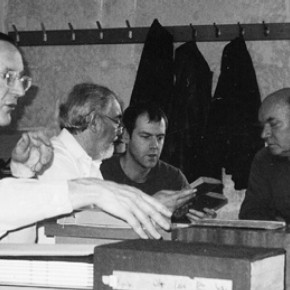Conservation Journal
Summer 2001 Issue 38
Introduction to Chinese Traditional Book Making
26-30 March 2001, St Aldate's Parish Centre, Oxford

Figure 1. David Helliwell discussing Chinese bindings and enclosures, Bodleian Library (click image for larger version)
Recently I had the opportunity to participate in this one week course given by Christopher Clarkson on traditional Chinese binding structures. There were 12 participants from 7 different countries. Our work space was intimate but friendly as the joy of Chinese binding structures is that they require little space as small hand tools are used rather than sophisticated equipment.
Two field trips were arranged to the Bodleian Library. The first was to the Chinese Department, where David Helliwell, the Librarian, discussed various Chinese bindings, their history and production, and showed us examples from the collection 1 (Fig. 1). The second trip was to the Japanese Department and it allowed us to compare the bindings.
The remainder of our time was spent making samples of the various styles of bindings:
- The concertina binding - a development from the scroll. Also known as Sutra or scripture bindings as used for Buddhist scriptures.
- Butterfly binding - developed around 1000 AD with the advent of printing. Each printed sheet was folded in half with the printed pages facing each other, the sheets were then pasted together at the fold.
- Wrapped back binding - To overcome the problem of blank pages in the butterfly binding the fold of the paper was reversed so that the printed pages were on the outside of a double leaf which was then held at the cut edges by paper screws, leaving the fold at the fore-edge. A paper cover was adhered at the spine. In general use during the Ming period of 1368-1644.
- Thread binding - The cover was sewn on rather than pasted - solving the problem of insect attack to the paste. This became the preferred format of the book until the end of the Imperial era and introduction of Western binding techniques at the beginning of the 20th C.
Printing was introduced during the T'ang Dynasty AD 618-916. Two pages were carved in reverse on blocks of wood - the sheet of paper being printed on one side only. The central area of the printed sheet is known as the banxin the 'heart of the printing block' along which the sheet of paper is folded. The banxin contains information such as title, chapter, page number and a device called a 'fish tail' which allows the sheet to be folded accurately in half. The shukou means 'the mouth of the book', and is where the book opens. The leaves are held together and flex at the shunao, the 'brain of the book'. Chinese books are arranged right to left and top to bottom.
Once bound, the fascicles 2 are grouped together and encased in a protective cover, the most common being the tao, a wrap around case open at both ends and fastened using bone pegs and loops. Space restrictions meant it was not possible to make a tao, but there was a demonstration on how to cut the board edges and line and cover the joints .
The course illustrated the intimate relationship between the book structure and printing, as well as the sympathetic nature of the materials. The bindings are light, suffer little deterioration and are easily handled without damage occurring. Where thread wears, the paper screws remain to hold the fascicle together. Silk corner protectors stop the corners becoming dog-eared and damaged. The bindings are both simple and effective. The tao is an excellent method of presenting and preserving written text and is easily replaced if worn.
References:
1 Helliwell, D. The Repair and Binding of Old Chinese Books translated and adapted for Western Conservators, The East Asian Library Journal, Spring 1998 Vol. VIII No. 1, pp 27-150
2 Fascicle (from the Latin for bundle) was used to describe each volume making up the whole edition.
Summer 2001 Issue 38
- Editorial - Desperately Seeking Eastern
- A Study Visit to Japan
- Review of MA Paper Conservation: Japanese prints
- A Chinese Figure in Unfired Clay: Technical Investigation and Conservation Treatment
- SIMS Analysis in Conservation Surface Studies
- Introduction to Chinese Traditional Book Making
- The Train stops at Gloucester Road - Futures and Values in Conservation
- The Resurrection of the Hereford Screen
- Printer Friendly Version